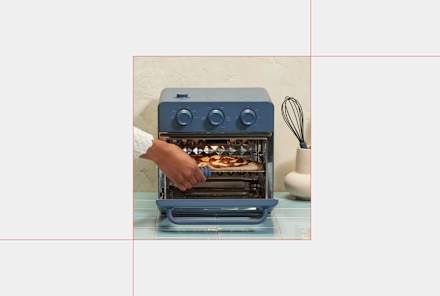Advertisement
The Top 5 Things You Can Do To Avoid Mold At Home This Year


Mold prevention isn't exactly a widely discussed topic—but it should be! Not only does preventing mold at home reduce costly remediation expenses down the road, but it can also help you avoid any adverse health reactions from mold exposure and poor indoor air quality. Not a bad deal.
To help make this year the best one yet for your indoor air quality and home environment, here are the top five steps to avoid mold growth in 2022:
Prioritize deep cleaning.
Staying on top of your home cleaning routine helps prevent mold in a few ways. For starters, mold spores and indoor pathogens can slip right in through the front door at any time, and since they're microscopic, you'd never know they were there.
Homes nowadays are also built with energy efficiency in mind, meaning that there's little airflow between the outside and inside environments. Saving on energy costs and emissions is a good thing, but it can keep tiny moldy particles trapped inside your home.
Deep cleaning regularly helps remove any spores and toxins that manage to make their way inside, improving your air quality and decreasing the likelihood that a spore will stumble on a nice little place to start growing.
Cleaning also helps remove dust and other particles that mold loves to eat. Removing as many food sources as possible can decrease the ability of mold species to grow, which is a plus-plus for your indoor space. Not to mention, since you can see dust, it's a good indicator of where all of those moldy particles collect. Since mold settles right where your dust does, removing dust will also remove any tiny particles that have gathered on it.
2. Maintain Your HVAC.
This step includes a few mini-steps, but all are important to ensure that your HVAC unit, the lungs of your home, isn't blowing mold particles through every single room.
The first part of this process is investing in HEPA filters and changing them on time per the manufacturer's instructions. These filters are required to remove at least 99.97% of dust, pollen, mold, bacteria, and any airborne particles with a size of 0.3 microns (µm). With microscopic particles like spores and mycotoxins, the smaller the sizes these filters can catch and remove, the better.
Scheduling a biannual HVAC technician to come out and service your system is a great preventive step, too. This individual will test for mold to ensure that when you switch your unit from heat to air or vice versa, you're not blowing moldy particles throughout your home. Condensation can build up in the unit with the temperature change, allowing hidden mold to begin growing. The technician should also clean the coil; make sure the blower, furnace, and cabinets are clean; and ensure that everything is operating correctly.
Focus on dehumidification.
The focus here is to maintain an indoor humidity level between 30 and 50%1. Any higher and you risk encouraging mold growth in your home.
To decrease the humidity level in your home, especially during the sticky summer months, you can:
- Crack a window or turn on the exhaust fan while showering to create airflow
- Turn on the exhaust fan or open a window while cooking in the kitchen
- Invest in a dehumidifier
- Close windows and doors on humid and/or rainy days
- Fix leaks and clean up spills ASAP
Invest in an air purifier.
As noted earlier, it's impossible to completely prevent outside particles from entering your home. Cleaning is a great way to remove them, but air purifiers can also help clear out any lingering ones.
If you do decide to invest in an air purifier, know that they're not all built the same. As I previously wrote on mindbodygreen, you'll want to go with a unit that removes the smallest particles possible and removes them all of the time. Not just some of the time. When you're dealing with inhalable particles like mycotoxins, the smaller an air purifier can filter out, the better.
Schedule annual inspections.
Mold growth can occur in the blink of an eye, and it doesn't always occur in visible areas. By scheduling routine inspections, a professional can come out to assess if there's a current hidden mold problem from a leak or if there are any structural issues that could lead to mold growth in the future.
A few areas they'll assess should include the roof for any leaks or weak areas, windows for any gaps from loose caulking or cracks, and exterior doors to ensure they're sealed properly.
Scheduling your own home inspection to check for hot spot locations for mold growth around your home is a phenomenal idea as well. Catching a problem early can help prevent it from spiraling into a much bigger issue.
These areas can include:
- The toilet tank (lift the lid and look inside)
- Underneath all the sinks
- The attic
- The basement
- Crawlspaces
The bottom line.
Collectively, these steps will help ensure your environment remains safe and healthy for you and your family so you can all breathe easy (literally) through 2022.
Watch Next
Enjoy some of our favorite clips from classes
Enjoy some of our favorite clips from classes
What Is Meditation?
Mindfulness/Spirituality | Light Watkins
Box Breathing
Mindfulness/Spirituality | Gwen Dittmar
What Breathwork Can Address
Mindfulness/Spirituality | Gwen Dittmar
The 8 Limbs of Yoga - What is Asana?
Yoga | Caley Alyssa
Two Standing Postures to Open Up Tight Hips
Yoga | Caley Alyssa
How Plants Can Optimize Athletic Performance
Nutrition | Rich Roll
What to Eat Before a Workout
Nutrition | Rich Roll
How Ayurveda Helps Us Navigate Modern Life
Nutrition | Sahara Rose
Messages About Love & Relationships
Love & Relationships | Esther Perel
Love Languages
Love & Relationships | Esther Perel


















